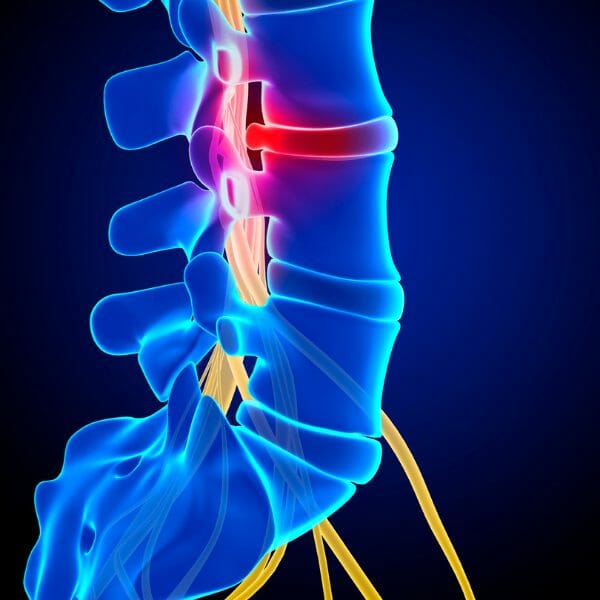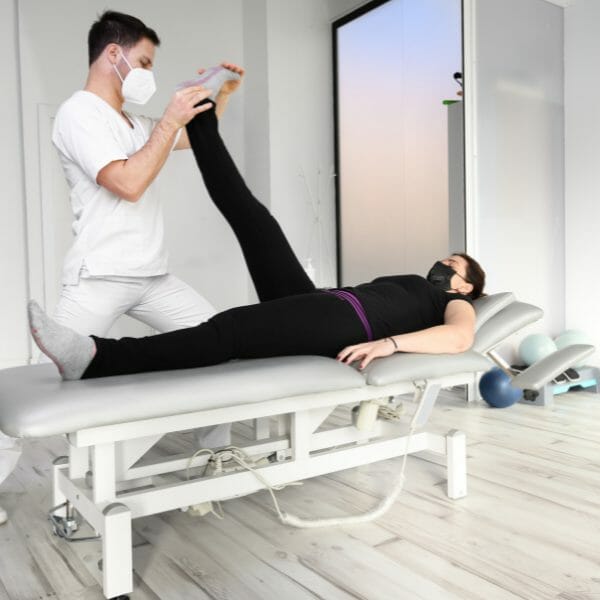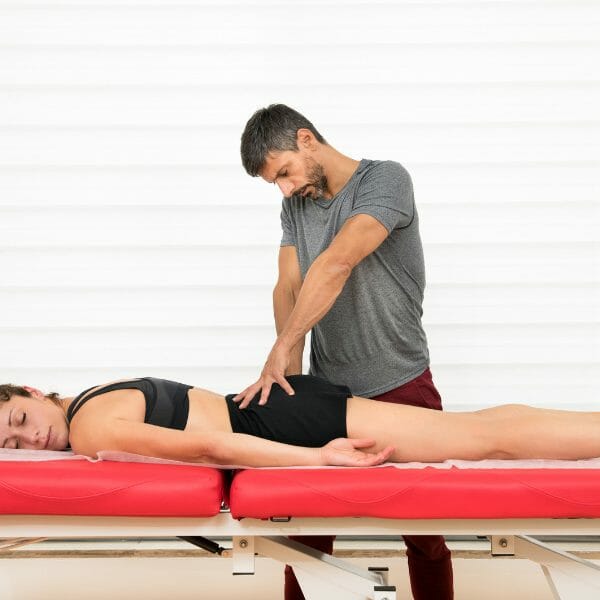Hip Pain Associated with Sciatica: Everything You Need to Know
Sciatica is a condition that can cause sciatic nerve pain in the hip and other areas of the body. Sciatica is caused by compression or irritation of the sciatic nerve, which runs from the lower back down the leg. This blog post will discuss the symptoms, causes, and treatment options for hip pain associated with Sciatica.
What is the Sciatic Nerve?

The sciatic nerve is the body’s longest and thickest (nearly finger-width) nerve. The lumbar spine, which runs along the bottom of your back, provides two roots, while the final section of your spine, known as the sacrum, provides three. The right and left sciatic nerves are formed when the five nerves come together. These nerves travel through the pelvis and buttocks before exiting the body to innervate (provide feeling to) the legs and feet.
What is Sciatica?
Sciatica is a condition that affects the sciatic nerve. Sciatica occurs when this nerve is compressed or irritated, it can cause pain, numbness, tingling and weakness in the legs.
What does Sciatica pain feel like?

The symptoms of Sciatica in the hip can vary from person to person. Sciatica pain in the hip is often described as a sharp, shooting pain that radiates from the lower back down the leg. Sciatica pain can also be accompanied by numbness, tingling and weakness in the legs. Sciatica pain is often worse when sitting or standing for long periods. Sciatica pain can also be worse when coughing or sneezing.
When one of the nerve roots in your lower back is irritated, the symptoms may spread along the sciatic nerve and produce sensations that run down your legs, usually only on one side. The signs of sciatica pain include:
- Severe pain in your lower back (lumbar region) that can be brought on by certain movements
- Pain that goes down your leg and into your foot or toes
- A pins-and-needles sensation or numbness in your leg
- Pain that gets worse when you sit, stand, or twist Sciatica
- Pain that improves when you lie down on your back.
Does Sciatica occur suddenly or take time to develop?
Sciatica can occur suddenly or gradually. Sciatica that arises suddenly is often caused by a herniated disc or a spinal tumor. Sciatica that slowly develops is often caused by degenerative disc disease or spinal stenosis (narrowing of the spinal canal).
What are the risk factors for developing Sciatica?
There are several risk factors for developing Sciatica, including:
- Age: Sciatica is more common in people over the age of 40.
- Obesity: Sciatica is more common in people who are obese.
- Smoking: Sciatica is more common in smokers.
- Sedentary lifestyle: Sciatica is more common in people who have a sedentary lifestyle.
- Pregnancy: Sciatica is more common in pregnant women.
Hip pain vs. Sciatica

Wear and tear is a common cause of hip pain. Wear and strain can lead to arthritis of the hip joint. Compression or irritation of the nerve roots in the back causes a pinched nerve or Sciatica.
PostureGeek.com Tweet
Wear and tear is a common cause of hip pain. Wear and strain can lead to arthritis of the hip joint. Compression or irritation of the nerve roots in the back causes a pinched nerve or Sciatica. While both problems may have similar symptoms, their distinction is critical for successful therapy.
What are the causes of Sciatica?

There are many different causes of Sciatica. Sciatica is often caused by a herniated disc, spinal stenosis or Piriformis Syndrome. Sciatica can also be caused by pregnancy, tumors, injury and other conditions.
Cause: Herniated Disc
One of the most common causes of Sciatica is a herniated disc. A herniated disc occurs when the gel-like center of a disc ruptures through its tough outer layer. This gel can put pressure on the Sciatic nerve and cause pain, numbness, tingling and weakness in the legs. Herniated discs are often treated with physical therapy, stretching and/or massage.
Cause: Spinal Stenosis
Spinal stenosis is a condition that occurs when the spinal canal narrows, putting pressure on the Sciatic nerve. This can cause pain, numbness, tingling and weakness in the legs. Spinal stenosis is often treated with physical therapy, stretching and/or massage.
Why do pregnant women get Sciatica?
Pregnancy can cause Sciatica because of the added weight and pressure on the spine and pelvis. Sciatica can also be caused by the baby’s position in the uterus. Sciatica is usually treated with physical therapy, stretching and/or massage.
What are Sciatica Symptoms?
Sciatica is characterized by pain that radiates from the lower back down the leg. Sciatica can also cause numbness, tingling and weakness in the legs. Sciatica is often worse when sitting or standing for long periods. Sciatica can also be worse when coughing or sneezing.
How do you know if it's a hip pain or Sciatica?

If you are experiencing hip pain, it is essential to see a doctor to rule out any serious underlying conditions. However, Sciatica is a common condition that can be treated effectively. If you are suffering from hip pain associated with Sciatica, many treatment options are available.
What's the difference between Sciatica and Piriformis Syndrome?
Sciatica is a condition that affects the sciatic nerve, which is the largest nerve in the body. The Sciatic nerve starts in the lower back and runs down through each buttock into both legs. When this nerve is compressed or irritated, it can cause pain, numbness, tingling and weakness in the legs. Sciatica is often caused by a herniated disc, spinal stenosis or Piriformis Syndrome. Sciatica pain hip can also be caused by pregnancy, tumors, injury and other conditions.
Piriformis Syndrome is a condition that occurs when the piriformis muscle irritates the sciatic nerve. The piriformis muscle is a small muscle located deep in the buttock. When this muscle contracts, it can compress or irritate the sciatic nerve, causing pain, numbness, tingling and weakness in the legs. Piriformis Syndrome is often treated with physical therapy, stretching and/or massage.
How is Sciatica diagnosed?
Your healthcare provider will ask about your medical history and symptoms. They will also perform a physical exam. Imaging tests, such as an MRI or CT scan, may also be ordered to help diagnose Sciatica.
How is hip pain associated with Sciatica treated?
The treatment for hip pain associated with Sciatica depends on the underlying cause.
Sciatica caused by a herniated disc, for example, is typically treated with:
- pain medication,
- physical and other forms of manual therapy and/or
- surgery.
Sciatica caused by spinal stenosis may be treated with:
- pain medication,
- physical and other forms of manual therapy and/or
- epidural injections.
Sciatica caused by Piriformis Syndrome is usually treated with:
- physical and other forms of manual therapy,
- stretching and/or
- massage.
If you are experiencing hip pain, it is important to see a doctor to rule out any serious underlying conditions. Sciatica is a common condition that can be treated effectively. If you are suffering from hip pain associated with Sciatica, many treatment options are available.
How can you prevent Sciatica?
There are a number of different things you can do to prevent Sciatica. Some of the most effective prevention methods include:
- Maintaining a good posture: Poor posture is one of the leading causes of Sciatica. By maintaining good posture, you can reduce the pressure on your spine and Sciatic nerves.
- Staying active and exercising regularly: A sedentary lifestyle is a significant risk factor for Sciatica. By staying active and exercising regularly, you can improve your flexibility and strength, which can help prevent Sciatica.
- Wearing comfortable, low heeled shoes: Wearing high heels or ill-fitting shoes can put additional strain on your back and Sciatic nerves. By wearing comfortable and supportive shoes, you can help reduce the pressure on these nerves.
- Maintaining a healthy weight: Excess weight can put additional strain on your back and Sciatic nerves.
- Avoiding prolonged sitting or standing: Prolonged sitting or standing can also put extra strain on your back and Sciatic nerves. by avoiding these activities, you can help reduce the amount of pressure on these nerves.
- Use proper lifting techniques at work or exercising: Improper lifting techniques can also lead to Sciatica. By using proper lifting techniques, you can help to avoid this condition.
How can Sciatic pain be treated?

If you are already experiencing Sciatica pain, there are several things you can do to treat it. Some of the most effective pain relief treatment methods include:
Rest: One of the best things you can do for Sciatica is to rest. This will help to reduce the inflammation and pain associated with Sciatica.
Exercise: Exercise is also an important part of treatment for Sciatica. By strengthening the muscles in your back and legs, you can help take pressure off your Sciatic nerves.
Physical therapy: This can also be an effective treatment for Sciatica. By stretching and strengthening the muscles in your back and legs, you can help take pressure off your Sciatic nerves.
Massage: Massage can also be an effective treatment for Sciatica. By relieving muscle tension, massage can help to reduce the amount of pressure on your Sciatic nerves.
Chiropractic care: Chiropractic care is also an effective treatment for Sciatica. By adjusting the spine, chiropractic care can help reduce the pressure on your Sciatic nerves.
Osteopathy: Osteopathy is also an effective treatment for Sciatica. By manipulating the bones and joints, osteopathy can help reduce the pressure on your Sciatic nerves.
Yoga: Yoga is also an effective treatment for Sciatica. By stretching and strengthening the muscles in your back and legs, yoga can help take pressure off your Sciatic nerves.
Workplace Ergonomics: Adjusting your workstation to be more ergonomic can also help overall sitting posture. By also ensuring that your computer screen is at eye level and that your keyboard and mouse are within easy reach, you can help reduce the strain on your Sciatic nerves.
Surgery: In some cases, surgery may be necessary to treat Sciatica. Surgery is typically only recommended if other treatments have failed to provide relief. If you are considering surgery, it is essential to talk to your doctor about the risks and benefits.
What can be done at home to relieve Sciatic pain?
You can do several things at home to help relieve Sciatica pain. Some of the most effective home treatment methods include:
Rest: One of the best things you can do for Sciatica is to rest. This will help to reduce the inflammation and pain associated with Sciatica.
Exercise: Exercise is also an important part of treatment for Sciatica. By strengthening the muscles in your back and legs, you can help take pressure off your Sciatic nerves.
Hot and cold packs:
- Ice: Ice can also be an effective treatment for Sciatica. By applying ice to the affected area, you can help to reduce inflammation and pain.
- Heat: Heat can also be an effective treatment for Sciatica. By applying heat to the affected area, you can help to reduce muscle spasms and pain.
Massage: Massage can also be an effective treatment for Sciatica. By relieving muscle tension, massage can help to reduce the amount of pressure on your Sciatic nerves.
When should I contact my healthcare provider?
If you are experiencing pain, you should contact your healthcare provider, including leg and groin pain. Your healthcare provider can help determine your pain’s cause and recommend the best treatment options for you.
Finally
Sciatica is a condition that causes pain in the hip and down the leg. Several treatment options are available, including rest, exercise, physical therapy, massage, chiropractic care, osteopathy, yoga and workplace ergonomics. However, surgery may be necessary in some cases. Home treatments that can help relieve Sciatic pain include ice, heat, and massage. If you are experiencing pain, you should contact your healthcare provider, who can help determine the cause and recommend the best treatment options for you.
PLEASE NOTE
PostureGeek.com does not provide medical advice. This information is for educational purposes only and is not intended to be a substitute for professional medical attention. The information provided should not replace the advice and expertise of an accredited health care provider. Any inquiry into your care and any potential impact on your health and wellbeing should be directed to your health care provider. All information is for educational purposes only and is not intended to be a substitute for professional medical care or treatment.
